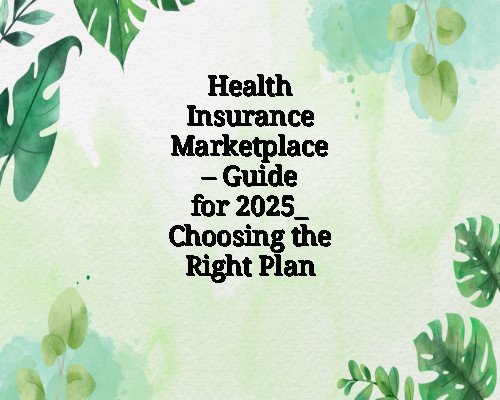Health Insurance Marketplace – Guide for 2025: Choosing the Right Plan
Understand how the 2025 Health Insurance Marketplace works and how to select the best plan for your financial needs, health requirements, and lifestyle.
Understanding the Health Insurance Marketplace in 2025
The Health Insurance Marketplace, also known as the Exchange, is a platform where individuals, families, and small businesses can shop for health coverage. Established under the Affordable Care Act (ACA), it allows you to compare health plans and find coverage that fits your needs and budget. In 2025, the Marketplace continues to play a vital role in expanding access to affordable healthcare coverage in the U.S.
Whether you’re self-employed, between jobs, or your employer doesn’t offer insurance, the Marketplace provides a structured way to obtain essential coverage.
What’s New in the 2025 Marketplace?
Enhanced Subsidies Continue
The American Rescue Plan’s increased premium subsidies have been extended into 2025. This means more Americans will qualify for financial assistance to lower monthly premiums—even those who previously earned too much to qualify.
Simplified Enrollment Process
The 2025 Marketplace offers an upgraded interface with a more user-friendly application process. Enhanced navigation tools help users compare plans, estimate out-of-pocket costs, and understand coverage levels more easily.
Expanded Plan Options
More insurers have joined the Marketplace in many states, offering increased competition and more choices for consumers. This provides greater flexibility in finding a plan that aligns with your healthcare and financial needs.
Special Enrollment Period (SEP) Changes
New qualifying events have been added in 2025 for Special Enrollment Periods, making it easier to obtain coverage outside the standard open enrollment timeframe.
Key Dates for the 2025 Enrollment Period
-
Open Enrollment Starts: November 1, 2024
-
Open Enrollment Ends: January 15, 2025
-
Coverage Begins: As early as January 1, 2025, depending on the date of enrollment
Missing the Open Enrollment period means you may only sign up during a Special Enrollment Period, triggered by events such as job loss, marriage, or birth of a child.
Types of Marketplace Plans
Marketplace plans are categorized into four metal tiers: Bronze, Silver, Gold, and Platinum. These categories are based on how you and your plan share costs.
Bronze
-
Lowest monthly premium
-
Highest out-of-pocket costs
-
Ideal for healthy individuals who need minimal care
Silver
-
Moderate monthly premium and cost-sharing
-
Eligible for Cost-Sharing Reductions (CSR) if you qualify
-
A balanced choice for many consumers
Gold
-
Higher monthly premiums
-
Lower out-of-pocket expenses
-
Best for those who expect regular medical care
Platinum
-
Highest monthly premiums
-
Lowest costs when you receive care
-
Best for those with chronic conditions or frequent medical needs
How to Compare Plans Effectively
Choosing the right plan involves more than just picking the lowest premium. Here are the key factors to evaluate:
1. Monthly Premium
The amount you pay monthly regardless of whether you use medical services.
2. Deductible
What you must pay for healthcare services before your insurance begins to pay.
3. Out-of-Pocket Maximum
The maximum amount you pay during a policy period before your insurance covers 100% of services.
4. Copayments and Coinsurance
Copay is a fixed amount you pay for services. Coinsurance is a percentage of the cost you share with the insurer after meeting your deductible.
5. Provider Network
Ensure your preferred doctors and hospitals are in-network. Out-of-network care is often more expensive or not covered at all.
6. Prescription Drug Coverage
Review the plan’s formulary (list of covered medications). Make sure your prescriptions are included.
Financial Assistance and Eligibility
Premium Tax Credits
These are based on income and household size. In 2025, individuals earning up to 400% of the Federal Poverty Level (FPL) may qualify, and in some cases, even those earning above this threshold are eligible due to the “benchmark plan” rule.
Cost-Sharing Reductions (CSRs)
Available only with Silver plans, CSRs lower deductibles, copays, and other out-of-pocket costs for eligible enrollees.
Medicaid and CHIP
Depending on your income and state, you may qualify for Medicaid or the Children’s Health Insurance Program (CHIP) through the Marketplace.
Tips for Choosing the Right Plan in 2025
Assess Your Healthcare Needs
Think about your medical history, any ongoing prescriptions, and potential health needs. If you only require annual check-ups, a Bronze plan may suffice. If you have ongoing conditions, look at Gold or Platinum tiers.
Estimate Total Yearly Costs
Add up premiums, deductibles, and expected out-of-pocket costs. A low-premium plan could become costly if you need frequent care.
Check Plan Ratings
Many plans now come with star ratings (1 to 5) based on customer satisfaction, care quality, and service accessibility. Use these as an additional tool when deciding.
Consider Telehealth Benefits
Many plans offer telemedicine services. If you prefer virtual consultations, ensure the plan includes robust telehealth options.
Review Before Renewing
Even if you liked your 2024 plan, review your options. Insurers update premiums, networks, and coverage annually.
Common Mistakes to Avoid
-
Focusing Only on Premiums: Ignoring deductibles and out-of-pocket costs can result in unexpected expenses.
-
Overlooking Provider Networks: Make sure your doctors and specialists are included.
-
Missing Enrollment Deadlines: Mark your calendar and act early to avoid losing coverage or facing gaps.
-
Not Reporting Income Changes: Your eligibility for subsidies can change if your income shifts. Always update your information.
Using a Broker or Navigator
Certified application counselors, navigators, and licensed agents can help you understand your options without pressure. These professionals are often free to consult and can help ensure you choose a plan that aligns with your needs.
Marketplace vs. Off-Marketplace Plans
Some insurers offer plans outside the Marketplace. However, these plans don’t qualify for subsidies and may differ in terms of coverage. Always compare side-by-side to ensure you’re getting value and financial assistance if eligible.
Health Savings Accounts (HSAs) and Marketplace Plans
If you opt for a High-Deductible Health Plan (HDHP) through the Marketplace, you may qualify for an HSA. Contributions are tax-deductible, grow tax-free, and can be withdrawn tax-free for qualified medical expenses.
HSAs are a great tool for those looking to manage future healthcare costs and save on taxes.
Final Thoughts: Making the Best Decision for Your Health and Wallet
Navigating the Health Insurance Marketplace in 2025 doesn’t have to be overwhelming. With more tools, enhanced subsidies, and expanded options, it’s easier than ever to secure quality, affordable coverage.
Evaluate your medical needs, budget, and priorities. Use comparison tools, seek professional help if needed, and always double-check the fine print. The right health insurance plan is an essential step in safeguarding both your health and your financial well-being.

